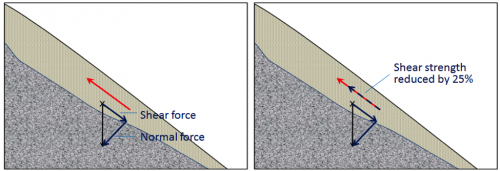Answers to Chapter 15 Review Questions
1. (a) The shear force and normal force vectors are shown on the left-hand diagram:
(b) Based on the relative lengths of the arrows it appears that this material is stable, and unlikely to fail.
(c) If the shear strength was reduced by 25% (right-hand diagram) the material would be much closer to failure, but the strength (based on the length of the arrows) still appears to be greater than the shear force.
2. 
3. In moist sand the grains are each surrounded by an envelope of water, and the water envelopes overlap. The attractive surface tension of the water holds the grains together.
4. In a the material moves like a fluid (individual particles move independently). In a the mass moves as an intact unit, with little or no relative motion between grains or clasts.
5. If a large rock slide starts moving at a rate of several metres per second, the rock is very likely to break into smaller pieces. If the pieces are small and numerous enough that the material can flow, then it becomes a rock avalanche.
6. A debris flow is composed mostly of sand-sized and larger clasts, while a mudflow is composed mostly of sand-sized and smaller clasts.
7. Residents at risk from Mt. Rainier lahars need to know what the warnings mean and roughly how much time they have between receiving a warning and being in actual danger. They need to create a plan to exit their residence quickly, and they need to know which way to go to get to safety as efficiently as possible.
8. Some of the important factors include:
- The steepness of the slope
- Any existing erosion processes happening at the base of the slope (e.g., wave or stream erosion)
- The nature of surface or shallow sub-surface drainage in the upper part of the slope, and any effects that the construction might have on the drainage
- The weight of the building (unless it is to be constructed in an excavation that represents more mass than the building itself)


